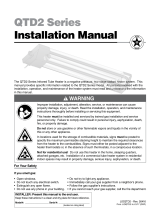16
OPTIONS
(5) Control Step Down Transformer - (STD)
The control step down transformer is located in the electrical
junction box. The transformer is used to step down the supply
power (115V, 208V, 230V, 460V, 575V) to 24V. This transformer is
used to control the gas controls, fan delay relay, field supplied
motor starter, etc. All unit heaters are supplied with a 40VA control
step down transformer. To determine the control transformer
supplied as well as any accessory/ field supplied transformers
required reference the supply voltage listed on the serial plate and
reference tables 16.1 and 16.2.
(6) High Limit Switch - (STD)
The automatic reset high limit switch is factory installed on the left
side (air blowing you in the face) of the unit heater. If the limit
temperature is exceeded, the gas controls are de-energized until
the switch is cooled.
(7) Blocked Vent Safety Switch - (STD)
A manual reset blocked vent safety switch (BVSS) is supplied on
all gravity vented unit heaters and is designed to prevent operation
of the main burner in the event there is spillage of flue products
into the space. This spillage may occur due to a restricted vent,
inadequate vent draw, uninsulated vent pipe in cold ambient or
long vent runs, excessive vent diameter, restrictive vent terminal,
negative pressure within space, etc. After the cause of the spillage
has been corrected, depressing the button of the BVSS found on
top of the unit may reset the BVSS. See trouble shooting section
for more information.
(8) Vent Pipe Connection - (STD)
All gravity vented unit heaters are supplied with an oval vent pipe
connection. This connection is sized to accept a piece of round
pipe that has been "flattened" to fit on the connection. Special
vent transitions are not required. If it is desired to use a rigid pipe
(i.e. 90° elbow) install a short transition piece to allow for the
change from oval to round.
(9) Blower Motor - (OPT)
The blower motor is factory installed on the blower housing. The
blower motor can be provided in a variety of supply voltages and
motor horsepowers. Refer to the model nomenclature to determine
the motor provided. The blower motor is supplied with an
adjustable sheave that can be used to increase/decrease the
blower RPM. For instructions on changing the blower RPM, refer to
Blower Adjustments.
Unit Power
((AAss ffoouunndd oonn SSeerriiaall PPllaattee))
For Gravity Vent
Voltage Phase Voltage Phase
115 1 115 1 11,25,30,59,63,81,83,85,87,89 115 to 24 none none
200-208 1 115 1 11,25,30,59,63,81,83,85,87,89 115 to 24 208V to 115V 208V to 115V
200-208 1 200-208 1 12,26,31,60,64,82,84,86,88,90 200-208 to 24 none none
200-208 3 115 1 11,25,30,59,63,81,83,85,87,89 115 to 24 208V to 115V ➀ 208V to 115V ➀
230 1 115 1 11,25,30,59,63,81,83,85,87,89 115 to 24 230V to 115V ➀ 230V to 115V ➀
230 1 230 1 12,26,31,60,64,82,84,86,88,90 230 to 24 none none
230 3 115 1 11,25,30,59,63,81,83,85,87,89 115 to 24 230V to 115V ➀ 230V to 115V ➀
460 3 115 1 11,25,30,59,63,81,83,85,87,89 115 to 24 460 to 115V 460 to 115V
575 3 115 1 11,25,30,59,63,81,83,85,87,89 115 to 24 575 to 115V 575 to 115V
Table 16.1
Electrical Details Propeller Units
➀ A transformer may not be required. 115V/1φ power may be obtained from the following electrical distribution systems: 230/1φ 3-wire, 230/3φ
4-wire, 208/3φ 4-wire and 208/1φ 3-wire (from 208V wye connected transformer). Please consult the job site electrician to determine applicability.
➁ Unit power code must match building supply voltage, control voltage must match unit power.
➂ For CSA Canada certification, step down transformer may be required to be factory installed (Blower Models Only).
Power
Building Supply
Voltage
Control Code Selected
Factory
Installed
Transformer
Additional Field Installed Transformers
Table 16.2
Electrical Details Blower Units
Unit Power
((AAss ffoouunndd oonn SSeerriiaall PPllaattee))
For Gravity Vent
Voltage Phase Voltage Phase
115 1 115 1 11,25,30,59,63,81,83,85,87,89 115 to 24 none none
200-208 1 200-208 1 12,26,31,60,64,82,84,86,88,90 200-208 to 24 none none
200-208 3 200-208 3 12,26,31,60,64,82,84,86,88,90 200-208 to 24 none none
230 1 230 1 12,26,31,60,64,82,84,86,88,90 230 to 24 none none
230 3 230 3 12,26,31,60,64,82,84,86,88,90 230 to 24 none none
460 ➁ 3 230 ➁ 3 26,60,64,84,88,90 230 to 24 460 to 230V ➂ 460 to 230V ➂
460 3 460 3 3,32,9,93 460 to 24 none 460 to 230V
575 ➁ 3 230 ➁ 3 26,60,64,84,88,90 230 to 24 575 to 230V ➂ 575 to 230V ➂
575 3 575 3 14,33,92,94 575 to 24 none 575 to 230V
Power
Building Supply
Voltage
Control Code Selected
Factory
Installed
Transformer
Additional Field Installed Transformers
For Unit w/ Power
Exhaust
For Unit w/ Power
Exhaust




















